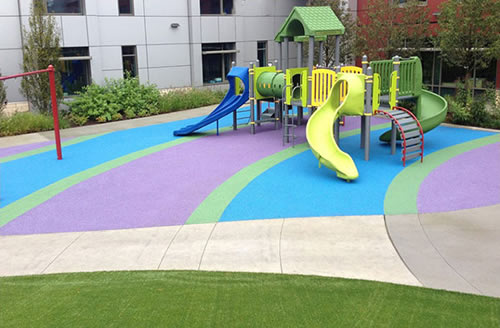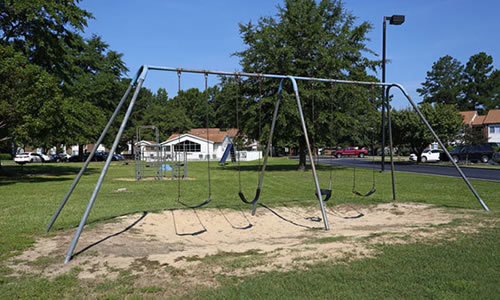articles
Children Will Fall At Playgrounds. What Shall We Do To Protect Them? A Multipart Blog Series - Part III: An Overview of Selected Playground Safety Technologies
By: Jeffery Warren & Aron Olson
Tel: 803-732-6600
Email Mr. Warren
View Profile on Experts.com.
Welcome to the third and final post in our multipart series of blog posts about a young boy's fall and serious injury at a public playground. In our first post we gave a brief overview of the incident and our investigation. In the second post we discussed some of the safety standards applicable to public playgrounds. In this post, we will examine some of the impact-absorbing playground surfaces available to protect children at playgrounds from injury. If you would like to read the first two posts, they are available here and here.
One way to control the fall hazard at public playgrounds is to install protective surfacing in areas where children may fall. Protective surfacing for playgrounds may be of a unitary type such as impact absorbing mats, rubber tiles, or rubber poured-in-place surfacing, or it may be loose-fill material such as wood chips, engineered wood fibers, sand or pea gravel. Both unitary and loose-fill materials need to be installed to a depth that will limit the deceleration experienced by a child who falls and strikes the surface to a level unlikely to cause a life-threatening head injury.
The depth of material required depends on the fall height of the playground equipment in the area on the impact-absorbing properties of the material. The Consumer Product Safety Commission's Handbook for Public Playground Safety and other industry standards provide guidance to help playground designers determine the fall height of the play equipment they install. The impact-absorbing properties of protective surfaces are determined by laboratory testing conducted by or for manufacturers of protective surfaces. Protective surfacing manufacturers generally specify a minimum required surface thickness for a given material and fall height.
Unitary protective surfaces often have a higher initial cost but may require less maintenance. Loose materials usually carry less initial expense but may need ongoing monitoring and maintenance to keep the material evenly distributed. Adequate drainage of water is an important design consideration. If water collects in a porous material and freezes, the impact-absorbing properties of the material may be lost.
Adequate protective surfacing needs to be installed throughout the use zone of playground equipment that carries a fall risk so that a child can only fall onto the protective surfacing. The size of the use zone depends on the type and size of the playground equipment. The Consumer Product Safety Commission's (CPSC) Handbook for Public Playground Safety contains information to help playground designers determine the size of the use zone for their playground equipment. Figure 1 below shows a playground with brightly-colored protective surfacing. A child playing on the elevated platform will not be able to fall onto the concrete walkway or other non-protective surface.

Figure 1: A view of a playground with impact absorbing surfacing. The brightly colored surfacing beneath the play equipment is a poured-in-place rubber and polyurethane material.
Hard materials that cannot protect children from life-threatening head injuries are not appropriate for the use zone of playground equipment. Materials that the CPSC Public Playground Safety Handbook describes as inappropriate include asphalt, concrete, dirt and grass. Children cannot be expected to appreciate the risks associated with falls from playground equipment and will, of course, use playground equipment whether it has adequate protective surfacing in its use zone or not. It is up to those who design and maintain public playgrounds to ensure that adequate protective surfacing is installed. The swing set shown in Figure 2 below does not have adequate protective surfacing in its use zone.

Figure 2: A view of a swing set without protective surfacing in its use zone. The packed earth and grass in the use zone of the swing set are not appropriate surfacing materials and there is a risk of life-threatening head injury if a child falls or jumps from the swing set.
Not all playground equipment needs protective surfacing material in its use zone. Play equipment at ground level or equipment that children use with their feet on the ground do not usually need impact absorbing surfacing. Examples include sand boxes, activity walls at ground level and ground-level play houses. Products, materials and site furnishings such as benches, tables and borders installed outside of use zones are not considered playground equipment and are not usually required to have protective surfacing.
We hope you have enjoyed our blog series public playground design and safety. If you have a case involving a fall injury at a playground, we encourage you to contact us. We at The Warren Group regularly add new material to our website, so please check back soon for new blog posts.
Jeffrey Warren, PhD, PE, CSP, is the chief engineer and CEO at Warren specializing in mechanical, machine design and safety. His deep expertise in machine design and safety analysis makes him a frequent presenter, trainer and expert witness. In addition to investigating more than 2000 claims involving property damage and injuries related to machinery and equipment since 1987, Jeff has an undergraduate degree in Mechanical Engineering from the University of North Carolina as well as a Master of Science and a Doctorate in Mechanical Engineering from Virginia Polytechnic Institute and State University - both with machine design emphasis.
©Copyright - All Rights Reserved
DO NOT REPRODUCE WITHOUT WRITTEN PERMISSION BY AUTHOR.


